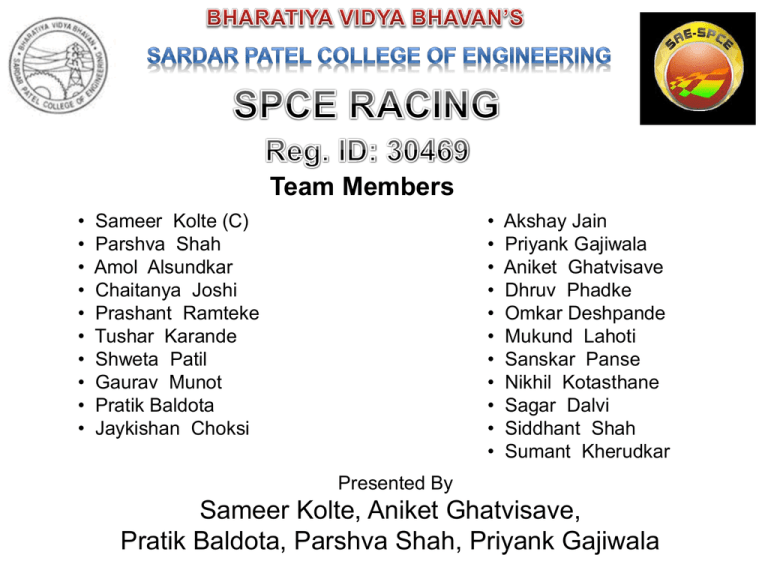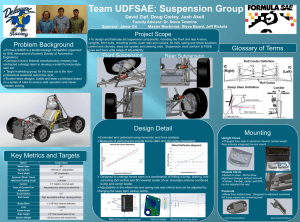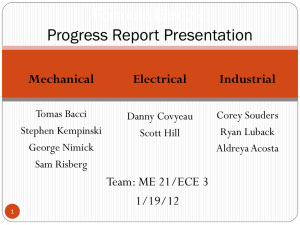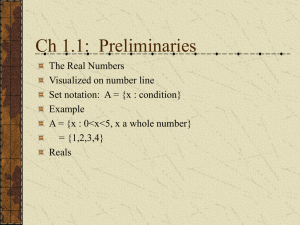30469_SPCE Racing
advertisement

Team Members • • • • • • • • • • • • • • • • • • • • • Sameer Kolte (C) Parshva Shah Amol Alsundkar Chaitanya Joshi Prashant Ramteke Tushar Karande Shweta Patil Gaurav Munot Pratik Baldota Jaykishan Choksi Akshay Jain Priyank Gajiwala Aniket Ghatvisave Dhruv Phadke Omkar Deshpande Mukund Lahoti Sanskar Panse Nikhil Kotasthane Sagar Dalvi Siddhant Shah Sumant Kherudkar Presented By Sameer Kolte, Aniket Ghatvisave, Pratik Baldota, Parshva Shah, Priyank Gajiwala Project Plan Roll cage Design: Material and Cross Section Selection • Material Used: AISI 1018 Structural Steel Property Value Ultimate Tensile Strength 460 MPa Yield Strength 365 MPa Density 7850 kg/m3 Young’s Modulus 2 x e11 N/m2 Poisson’s Ratio 0.26 - 0.3 Cross Section Moment of Inertia (mm4) Distance of extreme fibre (mm) Section Modulus (mm3) Area (mm2) Circular OD 1” 3mm Thick 12771 12.5 1022 207 Circular OD 1.25” 2mm thick 20774 15.875 1308.5 187 • Bracing: Circular cross section, OD =1”, pipe thickness= 2mm Roll cage Design: Design Methodology • Objective: To provide minimal 3-D space surrounding the driver and ensure safety. • Driver’s measurements: • RRH design: Roll cage Design: Design Methodology • RHO, SIM, FBM design : Roll cage Design: Finite Element Analysis Torsional Rigidity Torsional rigidity: 2500Nm/deg Stress Induced: 288MPa Flexural Rigidity Stress Induced: 107 MPa Roll cage Design: Finite Element Analysis Front Impact Front Impact: Force=7G=24034N Stress Induced= 319MPa Rear Impact Side Impact Rear Impact Force=5G=17167N Stress Induced= 123MPa Side Impact Force=3G=10300N Stress Induced= 334MPa Roll cage Design: Human Ergonomics • Side Impact Member Height: 9”; Kept close to minimum for less driver exit time. • Steering Wheel Position: Fixed according to driver comfort. • Driver Head Clearance: 7.5”; Kept greater than 6” as specified in rulebook. • RRH Inclination: 8 deg, fixed according to driver back leaning. • Width of chassis: Fixed such that there is clearance of 3” between any chassis member and driver body part. Suspension, Steering and Brakes: Chosen Configuration Brakes: • Type: Hydraulic disc brakes • Honda Aviator disc • Pulsar 220 calipers •Maruti 800 Master cylinder Suspension: • Type: Double Wishbone unequal arm suspension (Front ) Double Wishbone, Twin outer ball joint suspension (Rear) • Coil Spring and Hydraulic damping Steering: • Type: Ackerman Steering • Maruti 800 rack and pinion assembly Brake System • Human Foot force = 40kgf+ 20kgf(emergency) • Pedal Ratio = 4 • Use of proportionate valve to achieve front: rear brake biasing. • Calculated stopping distance: 3.6metres Suspension Design: Kinematics • Bump/Rebound travel: Front 200/-100, rear 200/-80 (mm) ; Roll angle: 5 degrees Front0.6 deg/deg Rear • Camber variation: Front: Static 0.85 Data deg/inch bump, roll Rear:Camber 1.34 deg/inch bump, 0.42 deg/deg0 roll angle 0 deg deg Caster angle 7 deg 0 deg Toe angle 0 deg 0 deg Kingpin angle 8 deg 6 deg Scrub Radius 90mm 120mm Caster Trail 23mm 0 mm Roll centre height 400mm 396mm • Toe Variation: ZERO bump steer and Roll steer Suspension design: Spring selection Objective: • To achieve desired ground clearance of 12” • To achieve ‘oversteer’ while cornering. Spring selection: • Rear springs: Maruti Zen Front struts Measured spring stiffness ‘k’ = 21N/mm Precompressive force= 140kgf • Front Springs: Inhouse designed springs Target spring stiffness ‘k’ = 21N/mm Wheel assembly components Hubs: • Front hub: Designed hubs Torsion and Bending Braking Torque= 235Nm Bending force= 1800N Max Induced stress= 71MPa Factor of safety= 6.5 • Rear hub: Maruti 800 front hubs Steering sub system • Ackerman geometry • C-factor = 37 mm/rev • Rack travel = 45mm • Wheel angles: Inner= 43deg, Outer= 35deg • Minimum Turning radius= 4 metres Powertrain: Engine Specifications: • Briggs and stratton 10bhp OHV engine • Torque: approx 18.75Nm at 2600 rpm • Power: 10bhp at 3600 rpm Briggs and Stratton Intek 20 Torque and Power 16 14 12 10 Torque (ft-lb) 8 Power (hp) 6 4 2 0 2000 2200 2400 2600 2800 3000 3200 3400 3600 3800 Engine Speed (RPM) Engine mounts: • Operating frequency range: 25 Hz to 70 Hz Engine Mounts Natural frequency= 460Hz Maximum stress induced= 23 Mpa Powertrain: Transmission Schematic: • Engine-> CVT-> Reduction gearbox • Continuously Variable Transmission 1. CVTech CVT Ratio= 3.6:1 to 0.59:1 2. Comet 780 series= 3.75:1 to 0.6:1 • Reduction gearbox Constant reduction = 10:1 • Final ratio= 36:1 to 5.9:1 Powertrain: Reduction Differential Input from CVT Output to driveshafts Total reduction: 11.45 Design Failure Modes And Effects Analysis (DFMEA) Items Potential Failure Mode Potential Cause of Failure Potential Effect Of Failure Remedies to avert Failure Chassis Structural Front/Rear/Side Collision Driver Injury, Chassis deformation, Damage to engine/suspension. Incorporate bracing members, Nodal Structure, Use of Bumpers. Fatigue Resonance of engine frequency with chassis natural frequency. Failure of welded joints Use of rubber pad below engine, Incorporate bracing to increase natural frequency Suspension (A-Arms, Springs, Shock absorbers) Structural Bending, compression, Force due to anti dive; Torsional shear failure of spring, Buckling Permanent buckling of spring affects ground clearance; Wishbone failure Rear twin Ball joint suspension , High Factor of safety Transmission Mechanical Cyclic loading, Radial loads due to CVT, Torsional shear stress in shafts Gear failure, Shaft failure, Misalignment of shafts in gearbox Use of standard shafts and gears, Bearings capable of taking high radial loads Brakes Structural Brake fluid contamination, Bending of brake pedal, Bending of master cylinder rod Brake system failure Master cylinder cap, Brake Bleeding, High FOS for pedal, proper Master cylinder mounting Safety • 5 point harness. • Battery placement: Away from rotating parts, Covered to prevent fuel spill on battery. • Front and rear bumpers to protect tie rod and toe link. • Master cylinder mount at height from base of chassis to prevent brake failure. • Resilient foam material on all pipes of cockpit. • Use of fire extinguisher. Summary Data Value Overall Length 90 inches Overall height 58 inches Track Width Front: 52 inches Rear : 50 inches Wheelbase 66 inches Gear Ratio 36:1 to 5.9:1 Estimated Weight of vehicle Gross Weight : 350 kg Kerb Weight : 290kg Estimated Weight of chassis 55 kg with all mounts and welds 3-D view of car




